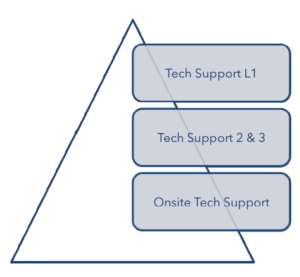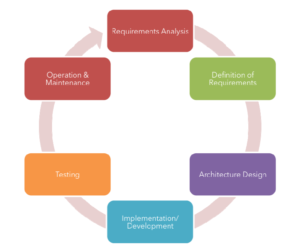Tech Support Outsourcing
The Tech Support Outsourcing will provide clients with 24×7 tech support management that will include proactive problem identification and resolution.Built-in root cause an potential problems before performance is affected. The Tech Support Outsourcing will automatically carry out clients’ pre-specified instructions to fix problems such as restarting sluggish servers and the applications that reside on them without human intervention.The Tech Support Outsourcing will also automatically dispatch on-site service providers to address high priority issues.By automating corrective actions , IT organisations decrease problem resolutions time and improve system availability.The Tech Support Outsourcing will provide clients with the following key services :
a- Tech Helpdesk Support
The Tech Support Team will be leveraging on the following ITIL Methodology in the Incident Management modules, which will be segregated into three (3) levels :

Level 1, Level 2 and third level or deep support. In short, the first level requires support engineers to answer calls, log calls, provide troubleshooting and problem resolution, and dispatch calls to second or third level support, if the problem is beyond the first level scope. At second level the support engineers are required to take calls escalated from first level support and resolve complex issues relating to operational aspects of the applications.At the third level support, engineers are expected to handle software bug and new development of the applications.
- i) Tech Support L1
This group will cover key processes like Receive Customer Calls and Create Tickets;Level one Responsibilities; Advice Customers; problem saving and escalation to Level Two.
- ii) Tech Support L2 and L3
This group will cover key processes like Receive Fully Qualified & Documented Calls; Level Two Responsibilities; Advice Customers; Problem Solving and Escalation to Level Three; Technical Consultant/Engineer Support.
iii) Onsite Tech Support
This group will provide IT hardware onsite technical support and will be offered as part of its IT support service product offerings. IT onsite support is often required as an extension of the IT help desk where onsite support engineers would be dispatched by the help desk or call center when fault could not be resolved remotely by the desk/center. This is currently managed by Individual Site location engineers.
b- System Replacement, Migration, and Integration
This service will provide the strategy and the execution resource for system replacement, upgrades, and migration. The support team will provide seamless integration on multiple applications via proven integration strategy and architecture such as Service Oriented Architecture (SOA). The implementation of the integration will utilize XML based SOAP & RESTful Web Services, Asynchronous Messaging (Queue System), and multiple protocols normalization via Enterprise Service Bus.
This service will assist clients to migrate legacy systems to new platforms such as Java and technologies such as Rich Internet Application (e.g. JSF,GWT) and industry standard databases such as Oracle & MS-SQL.
c- System Maintenance
This service Provides the support to operate, maintain, and monitor the existing application to achieve desired business continuity. The support team will recommend comprehensive tools to perform system monitoring and maintenance such as SNMP server to provide real-time feedback, alerting,and remediation.
2) Software Development Outsourcing
Organizations face the need to adapt themselves to a complex business environment, in continuous change and transformation. Under these circumstances, organization agility is a key element in gaining strategic advantages and market success. Achieving and maintaining agility requires agile architectures, techniques, methods and tools, able to react in real time to change requirements. OakEye Solutions’ S Outsourcing will provide clients with a comprehensive Software Development Life Cycle Services from ‘Conception to Deployment’. Throughout the lifetime of the software, owners may need ongoing assistance with updates to the hardware or software, new features, additional training, or troubleshooting.The Software Development Outsourcing will include the following Software Development Stages:

a- Requirements analysis and planning
Analysis of requirements is the most important stage in SDLC. It is performed by senior members of the team, using inputs from the clients,sales department, market research and industry experts. This information is then used for a basic project plan and feasibility study from economic,operational and technical points of view. Also, in this stage the team plans the quality insurance requirements and identifies project risks. The result of technical feasibility study consists of definition of carious technical approaches that can be used to implement the project with minimal risks
b- Definition of requirements
After the requirements are analysed, product requirements are clearly defined and documented. They must be approved by the client or by the market analysts through SRS (Software Requirement Specification). The SRS document lists all product requirements that must be designed and developed throughout the project life-cycle.
c- Architecture Design
SRS is the basic reference from which the architects set out to create the best architecture for the product. Usually, at least one product architecture approach is proposed, and it is documented in a DDS (Design Document
Specification). This DDS is revised by all interested parties and the best approach is selected, based on some parameters like: risk evaluation, product robustness, design method, budget and time constraints.
A design approach clearly defines all architectural modules of the product, along with communication and data flows to and from external modules provided by third parties (if there are any). Internal design of all modules in the proposed architecture must be presented in clear details by the DDS.
d- Implementation and Development
In this stage of the SDLC the product development starts. The source code is generated during this stage. If the design was performed in a detailed and organized manner, the source code can be performed without complications.
Developers must follow the guidelines of their organization. In order to generate the code they use programming tools like compilers, interpreters,debuggers etc. The source code is written in high level languages like C/C++, Delphi, Java, PHP. The programming language is chosen according to the software being developed.
e- Testing
This stage is usually a subset of all the stages in modern SDLC models, because testing is involved in all SDLC stages. Still, this stage only involves the situation where product faults are reported, tracked, fixed and reanalyzed
until it complies with the SRS quality requirements.
f- Operation and maintenance
Once the product has been tested, it is ready to launch on the market. It can be launched on a limited segment and tested in a real business environment, then, based on feed- back received, it can be launched to the whole market unchanged or with improvements suggested by clients involved in tests.After the launch, the maintenance is performed for the existing client pool.
The Software Development Outsourcing Service will offer clients with the following specific services:
a- Software Re-engineering
The essence of software re-engineering is to improve or transform existing software so that it can be understand, controlled, and used anew. The need for software re-engineering has increased greatly, as heritage software systems have become obsolescent in terms of their architecture, the platforms on which they run, and their suitability and stability to support evolution to support changing needs. Software re-engineering is important for recovering and reusing existing software assets, putting high software maintenance costs under control, and establishing a base for future software evolution.
b- Software Customization & Development
This service will provide clients with features addition, enhancement or customization on their existing software products to better suit business requirements. Development includes feature extensions, new features, integration with third-party products, user interface design, database integration, hardware interfacing, web applications and etc.
c- Software Localization
Whether in desktop applications, large-scale enterprise software, software embedded in sophisticated consumer electronics devices or a medical device system, local users will demand local-language versions of the software or
computer interface. Software Localization involves the extraction of translatable text from source applications, submitting the text for localization and rebuilding the application in any target language. The Software Localization Service will involve complex and technical tasks performed by our team of specialists, including translators, engineers, testers, graphic designers, programmers and project managers. Effective integration of these tasks is essential for the success of any given project.
d- Software Maintenance
Management time is increasingly coming under pressure in dealing with issues like technology obsolescence, profitability, human resource management, customer retention, release and management of versions, and the need to continuously improve processes. It has become increasingly clear to product development companies that support and maintenance of software products is a critical activity and this includes upgrades and other changes which have to be made quickly and effectively, while maintaining the quality of the product.
The Software Maintenance Service will include software maintenance support and service, deploying maintenance methodology for effective capture and reporting of maintenance requests. Services include Fault analysis, Design
Update, Upgrades and Patches, Code Review, Testing, Documentation Maintenance, and Software Enhancements.

